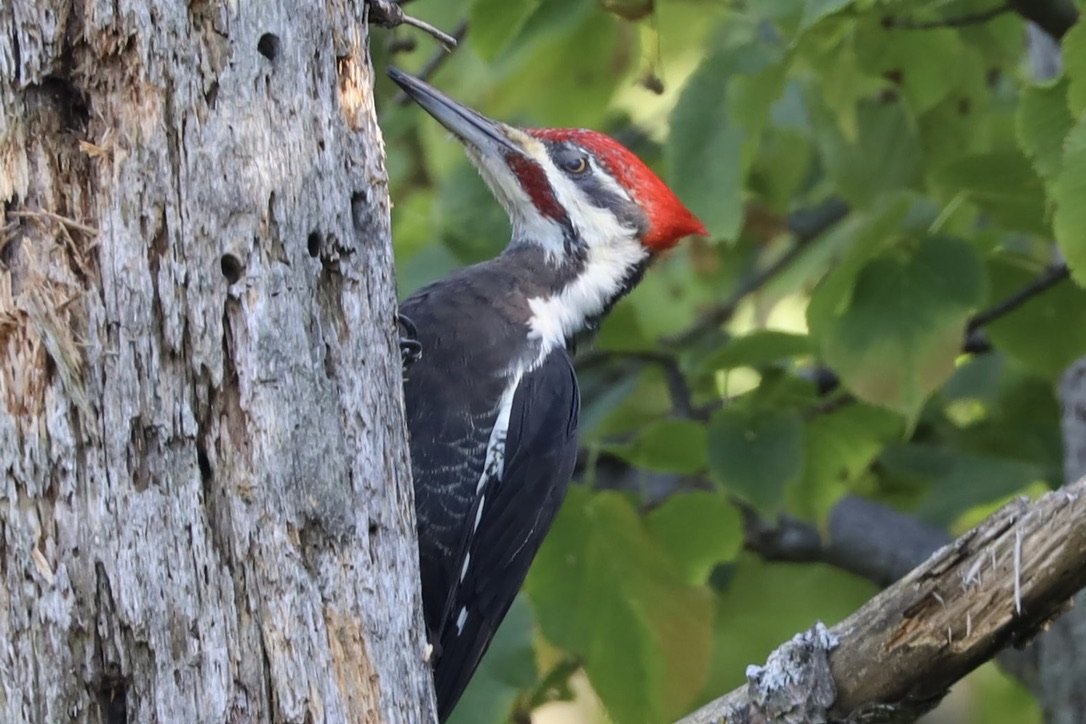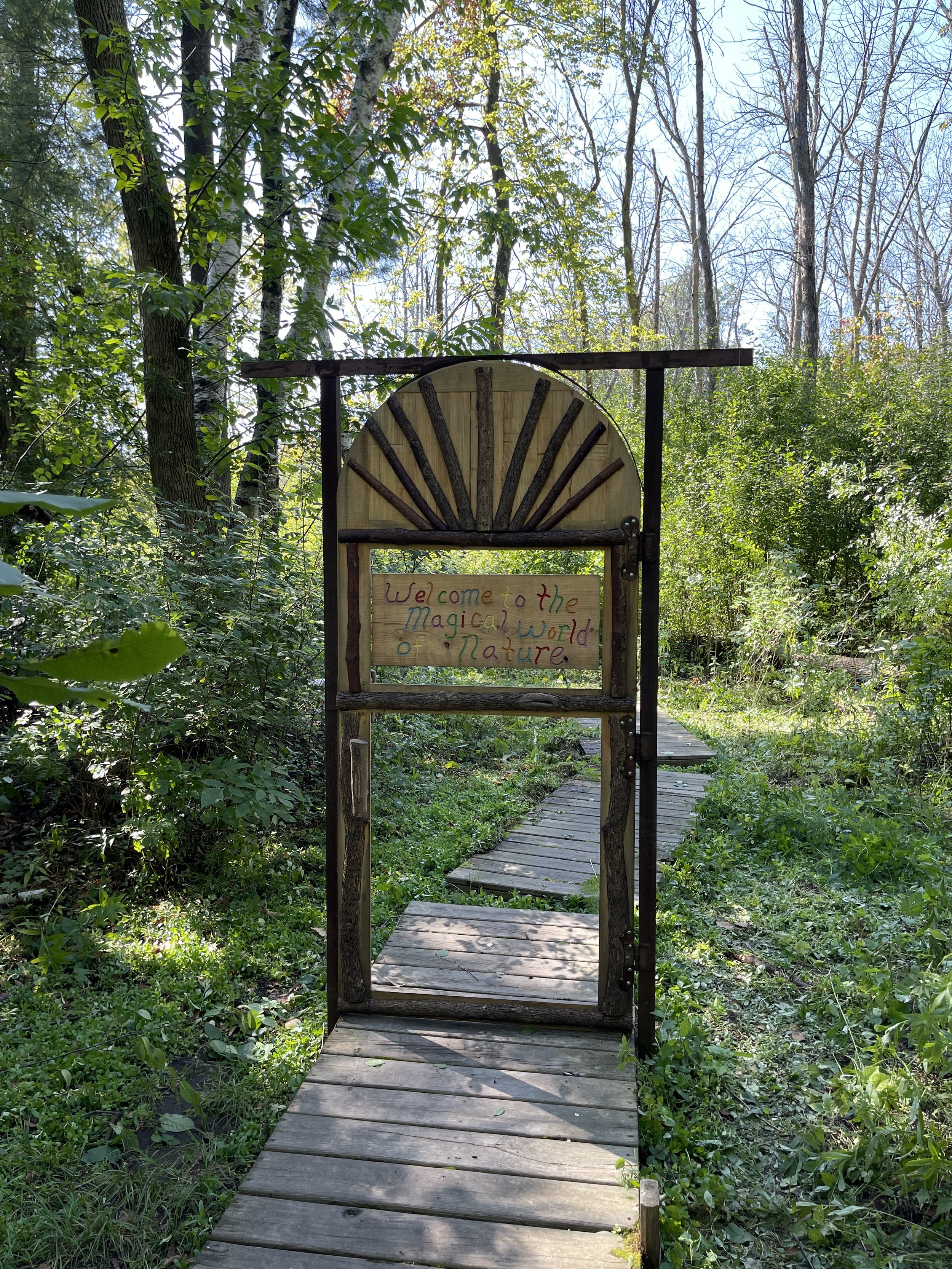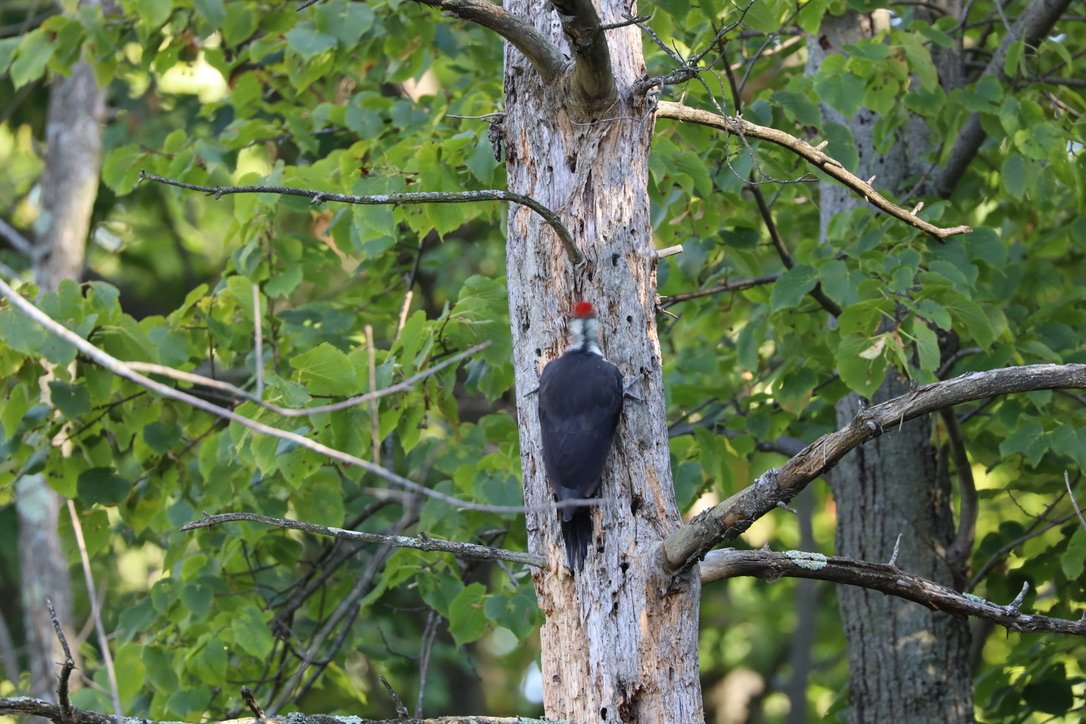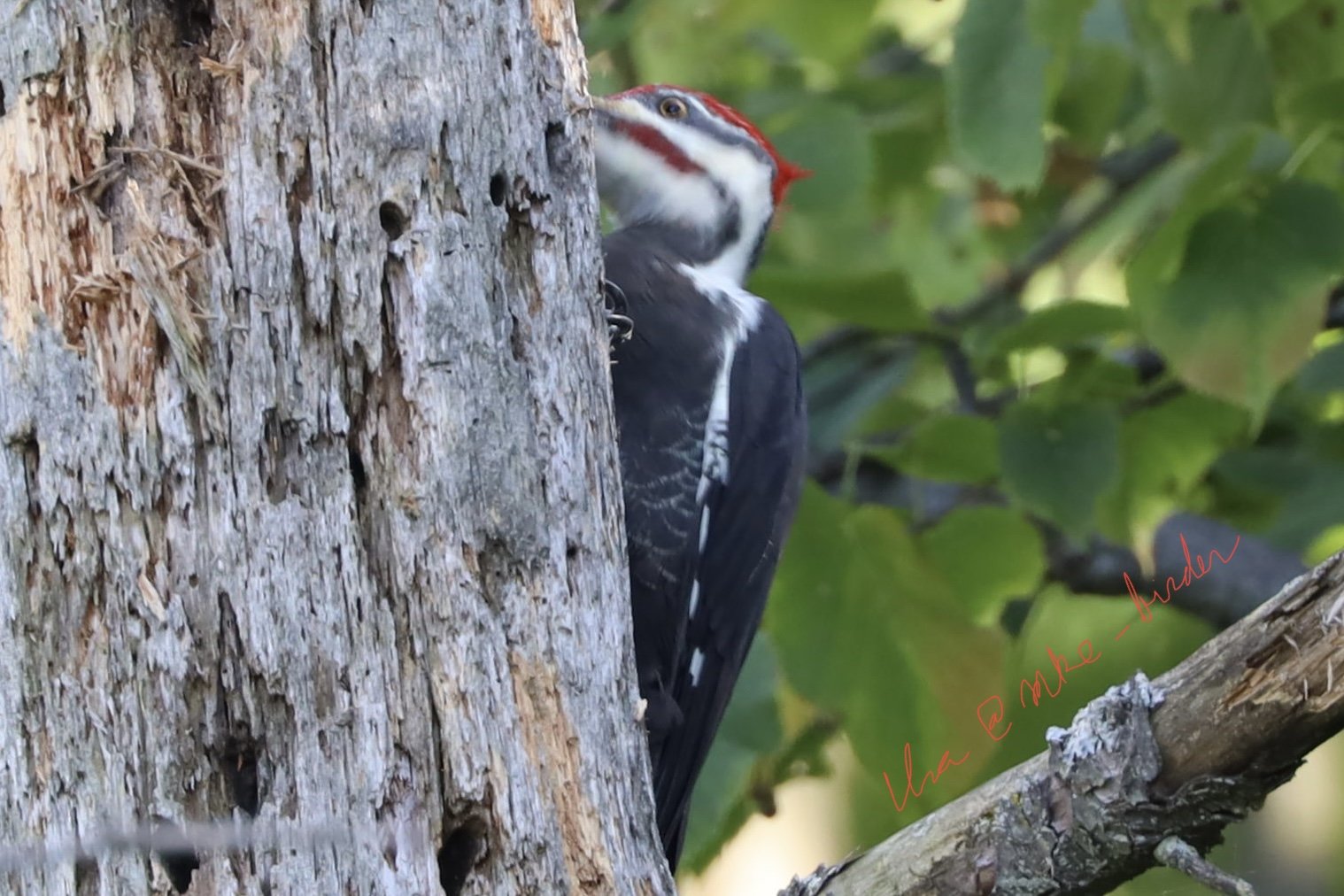
The Pileated Woodpecker versus the Sharp-Shinned Hawk
Or, My Day at the Schlitz Audubon Center
September 14th, 2023
I grew up just north of Milwaukee in a suburb called Fox Point. Nestled on the shores of lake Michigan, it’s a quiet village of a few thousand people, dotted with woodland and divided by dramatic ravines. In summer, when school was thankfully out, I was enrolled in day camp at the Schlitz Audubon Nature Center in neighboring Bayside. The property, formerly the Uihlein Schlitz family’s “Nine Mile Farm”, was donated to the National Audubon Society in 1971, and has since been a wonderful local resource for nature education and conservation efforts. Today, the Schlitz Audubon Nature Center (hereafter “Schlitz”) encompasses nearly 200 acres of diverse habitats, including forests and wetlands to restored prairies and the famous ravines.
More importantly, this is where a great love of nature—and eventually birds—was engendered.
****
Scoring a free day from work duties, I came to the Schlitz in the early afternoon. I would’ve come earlier, but non-birding chores such as returns took precedence. Besides, the Schlitz doesn’t even open until 9am, which is, to be honest, too late to take advantage of the avian morning commute.
Although it was a Thursday, the center was rather crowded with families and activities. A steady stream of people flowed through the parking lot from the forest to the visitor center when I arrived. I was worried that the trails would be too full, but my fears were assuaged when a number of cars started to leave.
I gathered my binos and camera and made way for the Lookout Tower south of the visitor center. Childhood memories of climbing breathless up the thirty feet of stairs always comes back to me when I ascend, but the view is worth it! I had been here the other day, where I had seen a Blue Jay, Red-Bellied Woodpecker, and a curious Black-Capped Chickadee. Today, apart from some Ring-billed and Herring Gulls making their rounds along the lakefront, it was all quiet at the canopy.
Underneath the lookout tower, a late-summer camp was carrying on in the shade of immense conifers. As I descended, I found myself singing along with their camp songs. “Johnny rings the bell, Johnny rings the bell. We are all friends, and Johnny rings the bell.” I’m not sure what that has to do with forest exploration. Bear deterrence?
****
Leaving the child chorus behind, I ventured south towards Mystery Lake, which was excavated by the center in the late 1980s. Here, too, I spent summers as a child catching bullfrogs at night. I can still remember getting muddy while grabbing their strong, slimy legs. But now, my purposes are definitely hand-off and cleaner. That, and I dought think the staff would appreciate a thirty-something wading into the water vying for awesome shots of warblers and pewees. More importantly, there are snapping turtles…
Compared to the day before, when scores of warblers hopped from tree to tree along the boardwalk, there was barely a chip from the pines. The occasional Eastern Wood-Pewee or Cedar Waxwing would sally from the dead branches from the island towards the boardwalk, but other than the usual suspects, no warblers were flying about in the early afternoon sun.
I proceeded, thus, along the Woodland Loop.
****
The Woodland Loop is, as its name accurately implies, is a circular path among the comparatively more remote mature hardwoods at the Schlitz. South of Mystery Lake, the loop is connected via a steep V-shaped staircase traversing a ravine. Aside from a family of three walking behind me, whom I let pass, the entry to the woods was still.
I look the path to the right, as I often do, and visited the Solitude Marsh. In recent years, a door greeted adventurers of all types to the marsh to find, I guess, solitude. And that’s what I found, along with plenty of cattails.
****
After visiting the marsh, I continued my journey to the right. By now, more activity was happening. American Redstarts flirted from branch to branch. White-throated Sparrows ducked among the thickets. Downy, Hairy, and Red-bellied Woodpeckers drummed on the myriad trees overhead. A Black-Capped Chickadee came within a foot of me to say hello (or to warn his compatriots of an intruder to the woods).
I’ve noticed that birds tend to become more active at certain times of the day: Early morning and late afternoon. This may be more empiric data based on my experience, and it may very well vary by region, but it’s a behavior pattern I’ve noticed since I started birding.
Towards the end of the loop, I heard a deep hooting. A Great Horned Owl! Excited, I tried to determine the direction the hooting emerged. Unfortunately, the owl was located deep in the southwest corner of the inaccessible forest on the other side of a ravine.
Oh, well.
I reached the V-shaped staircase at the end of the loop when I heard a maniacal laugh echoing from the woods behind me: cuk-cuk-CUK-CUK-CUK-CUK-cuk-cuk-cuk-cuk. I know that call! A Pileated Woodpecker!
****
The largest woodpecker in North America, the Pileated Woodpecker (Dryocopus pileatus) is an unmistakable resident of mature coniferous or deciduous forests. In the eastern USA, Pileated Woodpeckers (hereafter, PIWO) prefer to nest in dense forests near streams and bodies of water. The ideal trees tend to have large trunks, which is understandable given their large size.
These woodpeckers are widespread but uncommon and surprisingly difficult to locate. I often saw them in north and central Florida and around Atlanta, but not very often around Wisconsin, although I have heard their laughs in other parts of the state. Furthermore, they are scare in my neck of the woods (pun intended). I believe this is due to a relative paucity of mature hardwoods in the Milwaukee metropolitan area. On the Merlin app, there is a notable hole in SE Wisconsin where PIWO are not regularly found.
Another factor in their scarcity in the upper Midwest may be related to earlier hunting practices. Woodsmen and sportsmen, alike, would shoot PIWO for sport or food. Thanks to federal and state laws prohibiting widespread hunting, the PIWO’s population started to rebound, albeit slowly.
Fortunately, PIWO are considered a species of “Least Concern”.
****
Despite retracing my steps along the Woodland Loop, despite my best imitation skills at PIWO’s laugh, despite straining my neck skywards and mistaking a Northern Flicker for a PIWO, another hour was spent in vain!
The Great Horned Owl resumed its sonata.
Fearing I’d be locked in the property overnight, I made my way towards the parking lot via Mystery Lake.
****
The bugs, by this point, have become more lively with the setting sun and cooler temperatures. As I rounded the outdoor amphitheater, a couple of Palm Warblers and a House Wren hopping among the benches looking for these critters.
From the amphitheater, I walked onto the Mystery Lake boardwalk, again. No sooner had I rounded the corner when a large black-shaped bird with a fiery-red mohawk and white wing making flew over the water. To be honest, I thought I was hallucinating. (Do other birders have that phenomenon?) Realizing what it was, I immediately quickened by step to locate where the PIWO landed
Darn! It disappeared.
I made another complete circle along the lake without look and even returned to the woods. Thinking better of the situation, I returned to the water.
Lo and behold! A male PIWO was excavating a dead (Ash?) tree for food.
Switching between my binos and camera, I observed the PIWO for a good minute as it went about its business along the tree trunk. I am always gobsmacked whenever I see these magnificent birds. Their sheer size and prehistoric looks give them an uncanny resemblance of pteranodons or pterodactyls. They are also powerful! My first PIWO was in the Philadelphia suburb of Audubon on a snowy day with already a foot of snow on the ground. Away dug a PIWO as it made a huge hole. Then, as now, I stood in amazement.
As I stood here now, approaching closing time at the Schlitz, I wondered whether there is a relationship between more woodpecker activity and the invasion of the Emerald Ash Borer. (EAB) This insect, a stowaway from Asia that supposedly made its transoceanic journey in crates made of ash before landing in Detroit in the 1990s, has destroyed millions of acres of ash trees in the USA, with some of the most devastating effects in the upper Midwest. Efforts to tame the EAB have been few and far between. However, woodpeckers may be an answer to this problem, although studies have so far been inconclusive. While there has been an increase in woodpecker populations in some areas, this may be due more to restored habitat that to the increase in invasive species as a potential food source. That said, if we help to restore more suitable habitat, couldn’t we, as humans, provide woodpeckers and other essential native species a space to tame invasive insects, such as the EAB?
I hope so.
Perhaps this PIWO found some lingering EABs in the dead wood, or another food source. Whatever he was doing, he is a sign of a healthy environment.
****
After a few more jackhammers into the tree trunk, the PIWO flew into the heart of the trees, flashing its white underwings as it left. I scanned the canopy for him, relocating him on the bough of a mighty oak. In the field of view of my binos, I made out a shape of another bird in the oak just above the PIWO: An accipiter! Now, I will try to avoid anthropomorphizing the birds here, but as the PIWO looked up and saw the accipiter staring down on it, I could make out the avian equivalent of “Oh, crap!” as it fled amongst the leaves.
****
Before the pair departed, I noted the accipiter was notably smaller than the PIWO. The PIWO measures roughly 16.9”, which should be about the same size as a Cooper’s Hawk. With this in mind, and the help of the Sound ID function on the Merlin app, I confirmed the hawk to be a Sharp-shinned Hawk (Accipiter striatus), another uncommon bird for the region!
****
The PIWO and the “Sharpie” made a cycle of sorties through the trees, the woodpecker barely evading the small raptor. I must’ve stood on the boardwalk about 5 minutes, but it felt like a half an hour. As some point, the two disappeared from view.
I walked away fearing the PIWO had met his end. That would be the worst luck: Finding this large woodpecker, only to see it fall prey to a hawk less than two-thirds its size. As I attached the cap to my lens and put away my binos, I heard a faint mocking laugh from the conifers: cuk-cuk-CUK-CUK-CUK-CUK-cuk-cuk-cuk-cuk!
I smiled.
Copyright for the media within this post belongs solely to me.
If you enjoy my posts with their witty, thoughtful, and (sometimes) funny discussions, please feel free to #follow me for more!
Happy birding!
These photos were captured with a Canon EOS R RF100mm-500mm F4.5-7.1 L IS USM + 1.4x Extender.
Bibliography
https://www.villageoffoxpoint.com/DocumentCenter/View/4214/Fox-Point-A-Planned-Village#:~:text=Fox%20Point%20acquired%20its%20name,or%20nose%20of%20a%20fox.
https://www.schlitzaudubon.org/
https://www.birdsoftheworld.org/
https://www.audubon.org/news/birds-have-role-play-confronting-notorious-tree-killing-beetle
https://www.fs.usda.gov/features/fighting-invasive-emerald-ash-borers-woodpeckers-and-citizen-scientists
https://news.wttw.com/2016/04/07/more-pileated-woodpeckers-emerald-ash-borer-or-healthier-habitat

























